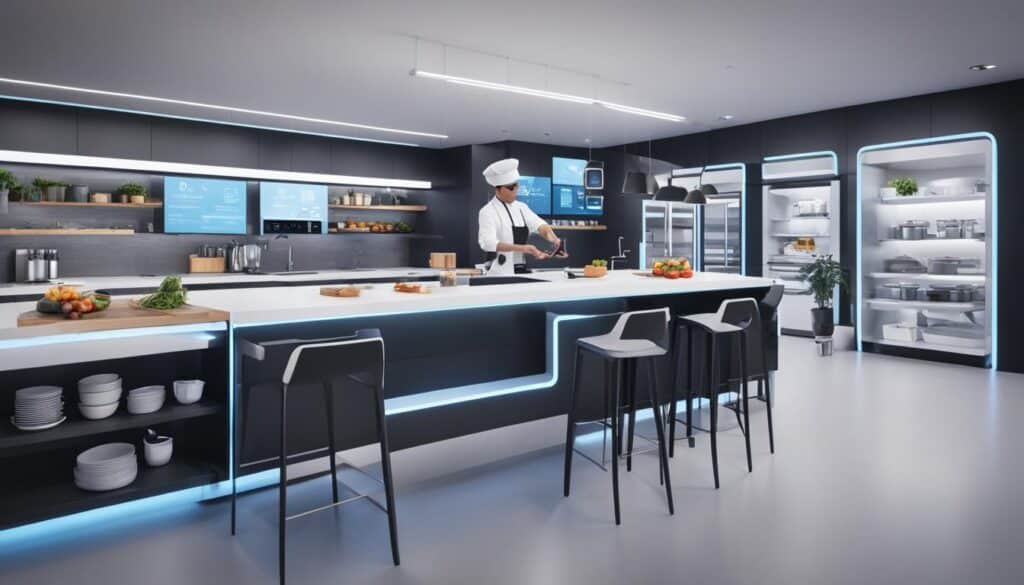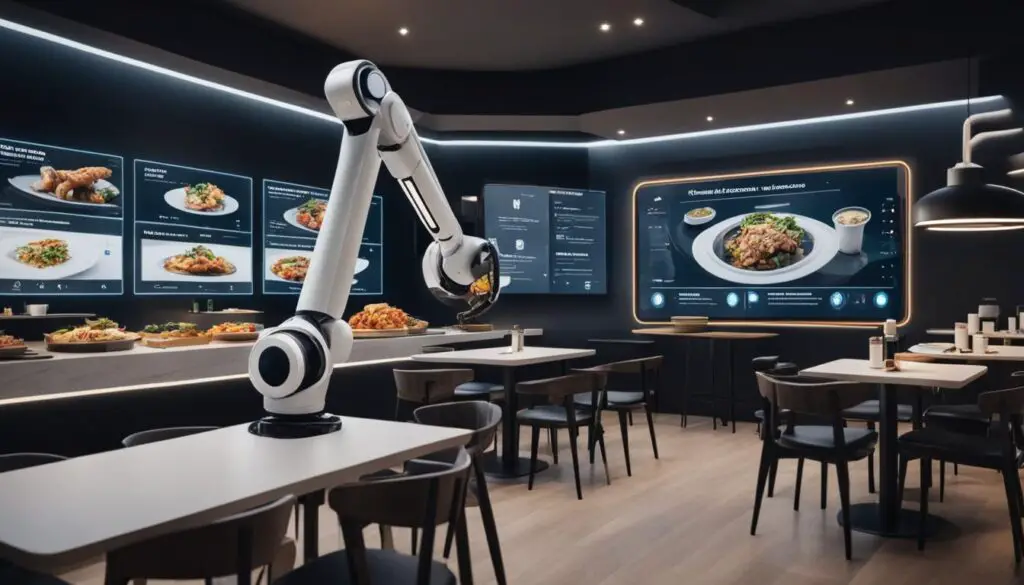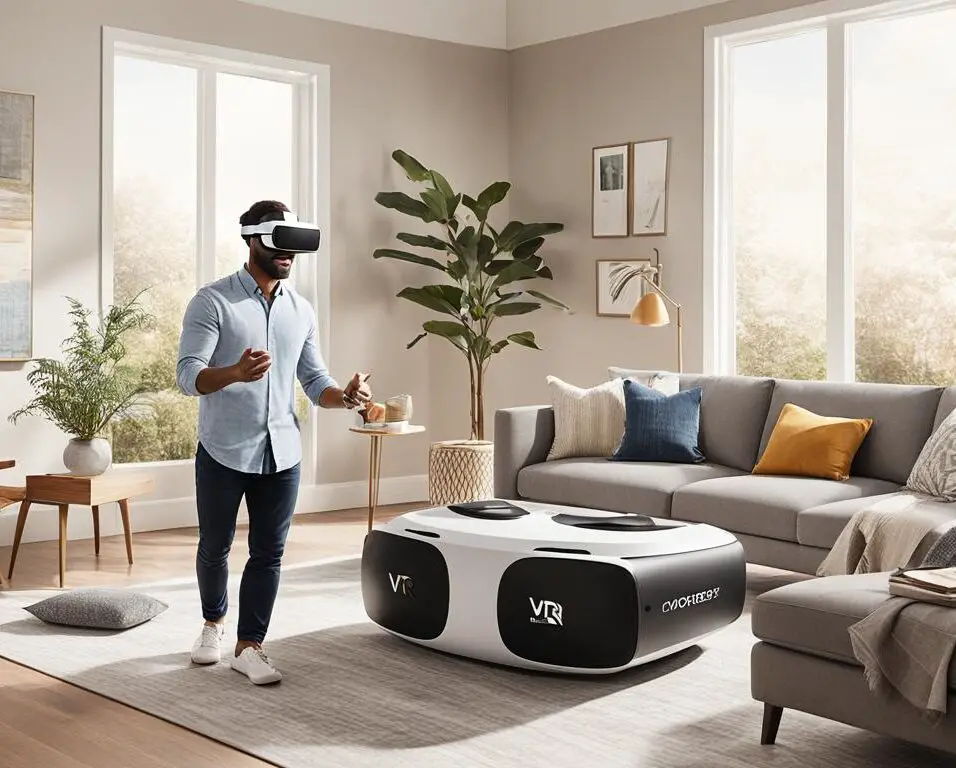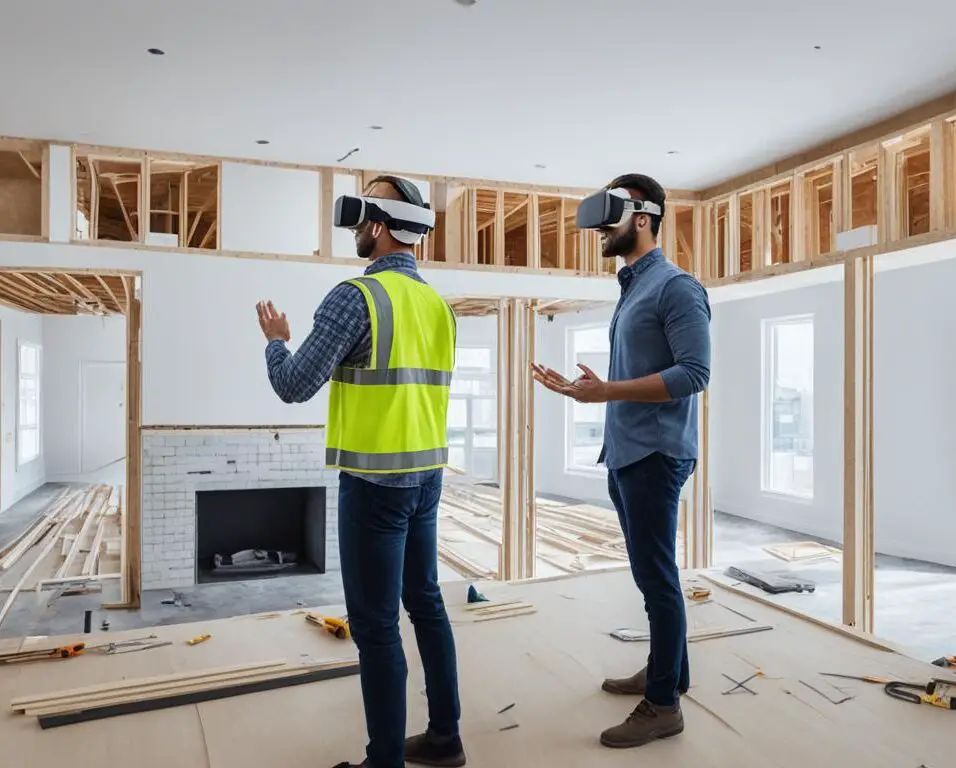Culinary Spaces Transformed: Innovative VR Kitchen Design Tools
Virtual Reality (VR) technology has revolutionized the way we experience and envision kitchen design. Innovative VR kitchen design tools are transforming culinary spaces, offering a glimpse into the future of remodeling. These tools utilize VR technology to provide users with an immersive and interactive design experience, allowing them to visualize their dream kitchens before making any physical changes. With the integration of VR, kitchen design is becoming more innovative, efficient, and personalized.
Key Takeaways:
- VR technology is redefining the kitchen design experience
- VR kitchen design tools offer an immersive and interactive design experience
- VR allows users to visualize their dream kitchens before making physical changes
- Kitchen design is becoming more innovative, efficient, and personalized with VR
- The future of remodeling is driven by VR technology
The Value of Geofencing in the Quick-Service Restaurant Industry
Geofencing has become an essential tool in the quick-service restaurant (QSR) industry. Industry giants like McDonald’s and Chick-fil-A have fully integrated geofencing into their operations, recognizing its immense value. With geofencing, restaurants can establish virtual boundaries and trigger actions based on users’ location, offering personalized experiences and enhancing operational efficiency.
The Power of Geofencing
McDonald’s, a frontrunner in the QSR industry, has leveraged geofencing to optimize its operations. One remarkable example is the implementation of the “Ready on Arrival” pickup technology, aiming to improve wait times by about 60 seconds in top markets by 2025. The geofencing feature of this technology alerts the restaurant when customers are in proximity, ensuring their orders are prepared and ready for pickup upon their arrival.
Through geofencing, QSRs can:
- Optimize order preparation
- Reduce wait times
- Enhance customer satisfaction
- Streamline logistics and delivery
With geofencing, both large and small QSRs can capitalize on its benefits. While industry giants like McDonald’s have the resources to implement geofencing technologies on a broad scale, smaller establishments can also adopt cost-effective solutions tailored to their specific needs.
Geofencing and Customer Engagement
Geofencing offers an opportunity for QSRs to engage with customers in a personalized and timely manner. By sending notifications and offers to customers when they enter a predefined geographic area, restaurants can effectively target and entice their audience. This personalized approach improves customer loyalty and drives repeat business.
A study conducted by xAd revealed that 54% of fast-food customers are more likely to visit a restaurant if they receive a location-based advertisement. Geofencing allows QSRs to precisely deliver relevant promotions or discounts to potential customers, increasing footfall and revenue.
“Geofencing technology has revolutionized the way we connect with customers. By utilizing location-based targeting, we can offer personalized promotions and drive customer engagement like never before. It’s a game-changer in the QSR industry.” – Marketing Director, Chick-fil-A
Case Study: McDonald’s and Geofencing
To provide a concrete example of geofencing’s impact, let’s take a closer look at how McDonald’s has incorporated this technology into their operations:
| Restaurant | Average Wait Time (pre-geofencing) | Average Wait Time (post-geofencing) |
|---|---|---|
| McDonald’s A | 5 minutes | 3 minutes |
| McDonald’s B | 5 minutes | 2 minutes |
| McDonald’s C | 6 minutes | 4 minutes |
The implementation of geofencing technology has significantly reduced wait times at McDonald’s locations. Customers can now enjoy their meals faster, enhancing their overall dining experience. This improvement in efficiency translates into increased customer satisfaction and greater brand loyalty.
As geofencing continues to shape the QSR industry, smaller establishments can also harness its power, democratizing access to this technology. By embracing geofencing, quick-service restaurants can drive operational efficiency, offer personalized experiences, and stay ahead of the competition.
Contactless and Automation in the QSR Industry
The ongoing pandemic has rapidly accelerated the adoption of contactless services and automation in the quick-service restaurant (QSR) industry. As customers prioritize safety and convenience, restaurants have embraced technologies that minimize physical contact and optimize operational efficiency. From self-service kiosks to mobile ordering apps and the integration of robotics, the QSR industry is revolutionizing the customer experience.
Enhancing Safety and Speed with Contactless Services
Contactless services have quickly become a norm in the QSR industry, allowing customers to place their orders and make payments without direct contact. Self-service kiosks provide an efficient and user-friendly way for customers to customize their orders and make transactions. These kiosks not only streamline the ordering process but also reduce the potential for errors and improve order accuracy.
Another key aspect of contactless services is the rise of mobile ordering apps. Customers can now browse menus, place orders, and pay through their smartphones, eliminating the need for physical menus and cash transactions. Mobile ordering apps offer convenience, personalization, and the ability to track orders in real-time, ensuring a seamless and efficient dining experience.
Streamlining Operations with Automation
Automation plays a vital role in streamlining operations and improving efficiency in the QSR industry. With the integration of robotics, tasks such as food preparation, order assembly, and even delivery can be automated, reducing human error and ensuring consistent quality.
Self-ordering kiosks and digital menu boards optimize the ordering process by minimizing human intervention and allowing customers to customize their orders based on their preferences. This not only speeds up the ordering process but also enhances customer satisfaction and improves order accuracy.
Revolutionizing the Customer Experience
By embracing contactless services and automation, the QSR industry is redefining the customer experience. These technologies offer convenience, speed, and the assurance of safety in a post-pandemic world. Customers can enjoy a seamless dining experience, from placing their orders to receiving their meals, without the need for extensive human interaction.
Moreover, automation allows restaurants to allocate their workforce more efficiently, focusing on tasks that require human expertise and personalization while reducing labor costs and increasing overall operational efficiency.
Overall, the integration of contactless services and automation in the QSR industry aligns perfectly with the priorities of speed, convenience, and reducing human error. These technologies not only enhance safety but also revolutionize the customer experience, ensuring a seamless and efficient dining experience for all.

| Benefits of Contactless Services and Automation in the QSR Industry |
|---|
| Enhanced safety and hygiene for customers and employees |
| Improved order accuracy and reduced human errors |
| Streamlined operations and increased efficiency |
| Personalized customer experiences through self-service options |
| Reduced labor costs and optimized workforce utilization |
The Role of AI in Quick Service
Artificial Intelligence (AI) plays a crucial role in revolutionizing the quick-service industry, enabling intelligent data utilization and transforming the way businesses operate. It goes beyond the realm of futuristic robot-run kitchens to offer practical applications such as predictive analytics for inventory management, personalized customer engagement, and efficient staffing. With AI-powered technology, decision-making and strategy are significantly influenced by insights derived from data intelligence rather than mere data collection.
AI’s impact on inventory management is profound. By leveraging predictive analytics, quick-service restaurants can optimize their inventory levels based on historical data, seasonal trends, and real-time demand fluctuations. This ensures better cost control, minimizes wastage, and enhances overall operational efficiency. Through AI-driven inventory management, businesses can maintain optimal stock levels, streamline procurement processes, and make data-driven decisions to maximize profitability.
The Benefits of AI in Quick Service:
- Improved Inventory Management: AI enables predictive analytics to optimize inventory levels and minimize waste.
- Efficient Staffing: AI-powered scheduling algorithms analyze historical data to forecast labor demands, ensuring the right staff is scheduled at the right times.
- Enhanced Personalized Customer Engagement: AI algorithms analyze customer data to provide personalized recommendations, offers, and targeted marketing campaigns, ultimately improving customer satisfaction and loyalty.
- Streamlined Operations: AI-powered automation simplifies routine tasks, allowing staff to focus on providing exceptional customer service and optimizing operational efficiency.
- Data-Driven Decision Making: AI algorithms process vast amounts of data to generate valuable insights that inform strategic decision-making, enabling businesses to stay ahead of market trends and customer demands.
AI’s ability to analyze customer data and deliver personalized experiences is a game-changer in the quick-service industry. By leveraging AI algorithms, businesses can create customized menus, offer tailored recommendations, and provide personalized promotions based on individual customer preferences and purchase history. This level of personalized customer engagement fosters loyalty, drives repeat visits, and boosts overall revenue.
Furthermore, AI-powered chatbots and virtual assistants enhance customer interactions by providing quick and accurate responses to inquiries, improving customer satisfaction and reducing wait times.
To highlight the role of AI in the quick-service industry, consider the following table showcasing key benefits:
| Benefits | Examples |
|---|---|
| Improved Inventory Management | Optimized stock levels, reduced wastage, and better cost control |
| Efficient Staffing | Data-driven scheduling algorithms for optimal labor management |
| Personalized Customer Engagement | Customized menus, tailored recommendations, and personalized promotions based on customer preferences |
| Streamlined Operations | Automation of routine tasks to optimize efficiency |
| Data-Driven Decision Making | Valuable insights derived from data analysis to inform strategic decisions |
AI is revolutionizing the quick-service industry, offering quick-service restaurants the opportunity to enhance efficiency, improve customer satisfaction, and drive growth. By harnessing the power of AI, businesses can unlock the full potential of their operations and stay ahead in today’s competitive market.

Personalization in Quick Service
In 2024, personalization in the quick-service industry has evolved beyond basic customization. Quick-service restaurants are now harnessing the power of customer data to deliver personalized experiences, menu recommendations, and offers that cater to individual preferences. This level of personalization plays a crucial role in building deeper customer relationships, fostering loyalty, and providing services that truly resonate with each customer.
By leveraging customer data, quick-service restaurants can gain valuable insights into individual preferences, such as favorite dishes, dietary restrictions, and preferred dining occasions. Armed with this information, restaurants can offer customized menu recommendations to enhance the overall dining experience. Whether it’s suggesting new dishes based on past orders or providing personalized meal packages, these tailored recommendations create a sense of exclusivity and make customers feel truly valued.
Utilizing Customer Loyalty Programs
Customer loyalty programs are an invaluable tool for personalization in the quick-service industry. These programs allow restaurants to gather and analyze customer data, from order history to dining preferences. Armed with this knowledge, quick-service establishments can create tailored offers and incentives to reward loyal customers and encourage repeat visits.
For example, a restaurant could offer special discounts or freebies on a customer’s birthday or anniversary, making the dining experience feel even more special. By providing personalized perks, quick-service establishments can build stronger bonds with customers, increasing loyalty and driving customer retention rates.
Delivering Targeted Promotions
Personalization extends beyond the dining experience itself. Quick-service restaurants can use customer data to deliver targeted promotions and offers, ensuring that customers receive relevant and appealing deals. By analyzing customer preferences and purchase history, restaurants can send personalized offers directly to customers’ mobile devices, enticing them to visit and indulge in their favorite dishes.
For instance, if a customer frequently orders vegetarian dishes, the restaurant can send targeted promotions, highlighting new vegetarian options or limited-time discounts on plant-based meals. This not only increases the chances of customers engaging with the promotion but also demonstrates that the restaurant understands and caters to their specific preferences.
Enhancing the Ordering Process
Personalization also plays a role in streamlining the ordering process, making it quicker and more efficient for customers. Quick-service restaurants can utilize customer data to create personalized order history, enabling customers to quickly reorder their favorite items with just a few taps on their mobile devices. This level of convenience not only saves time for customers but also enhances their overall experience with the brand.
Additionally, restaurants can leverage customer data to personalize the digital ordering interface. By prominently featuring previously ordered dishes or suggesting complementary items based on past preferences, quick-service establishments can make the ordering process more intuitive and engaging. This personalized touch ensures that customers feel valued and understood, ultimately leading to increased customer satisfaction and loyalty.
As personalization becomes a cornerstone of the quick-service industry, restaurants that prioritize customer data and utilize it effectively will gain a competitive edge. By tailoring experiences, menu recommendations, and offers to individual preferences, quick-service establishments can forge stronger customer relationships, enhance loyalty, and deliver unparalleled service.
Streamlining Operations with Smart Technology
The integration of smart technology in restaurant operations is revolutionizing the way quick-service restaurants function. With the use of smart technology, restaurants can streamline their processes and achieve unprecedented levels of efficiency and agility. From dynamic inventory management systems to AI-driven predictive maintenance, these technologies are solving current challenges and adapting to future needs, ensuring resilience in the face of changing market demands.
The Benefits of Smart Technology
Implementing smart technology in restaurant operations brings various benefits:
- Efficient inventory management: Smart inventory management systems use real-time data to track stock levels, optimize ordering, and prevent wastage. This improves accuracy, reduces costs, and ensures timely availability of ingredients and supplies.
- Predictive maintenance: By leveraging AI and data analysis, restaurants can proactively identify and address equipment maintenance needs. Predictive maintenance helps prevent breakdowns, reduces downtime, and extends the lifespan of kitchen equipment, saving costs in the long run.
- Enhanced agility: Smart technology enables restaurants to quickly adapt to changing situations. With real-time data and analytics, businesses can make informed decisions, adjust operations, and optimize resource allocation.
Through the synergistic application of these technologies, quick-service restaurants can operate more efficiently, provide better customer service, and reduce complexities in their day-to-day operations. By embracing smart technology, restaurants can achieve significant cost savings and improve their overall business performance.
Implementation Challenges and Solutions
While the adoption of smart technology brings immense benefits, it also comes with certain implementation challenges. Key challenges include:
- Integration complexities: Introducing new technologies can involve integrating multiple systems and processes, which may require technical expertise and change management.
- Staff training: Employees need to be trained to effectively utilize and maximize the capabilities of smart technology.
- Data security: With the increased use of technology, ensuring the security and privacy of customer and business data becomes paramount.
To overcome these challenges, restaurants can:
“By partnering with reputable technology providers and investing in comprehensive training programs, restaurants can overcome integration complexities and equip their staff with the necessary skills. Implementing robust data security measures and privacy policies can also safeguard sensitive information.”
Comparing Smart Technology Solutions
| Technology Solution | Key Features | Benefits |
|---|---|---|
| Dynamic Inventory Management System | – Real-time tracking – Automated reordering – Analytics-driven insights |
– Improved accuracy and efficiency in inventory management – Cost reduction through better supply chain management – Timely availability of ingredients and supplies |
| AI-Driven Predictive Maintenance | – Data analysis for equipment health monitoring – Predictive equipment maintenance scheduling – Preventive maintenance alerts |
– Increased equipment uptime and reduced downtime – Cost savings through lower repair and replacement expenses – Prolonged lifespan of kitchen equipment |
| Real-Time Analytics Dashboard | – Centralized data visualization – KPI tracking – Customizable reports and insights |
– Instant access to key performance metrics – Data-driven decision-making – Improved operational efficiency |
Incorporating smart technology into restaurant operations is a game-changer for quick-service establishments. By leveraging dynamic inventory management systems, AI-driven predictive maintenance, and real-time analytics, restaurants can optimize their processes, improve efficiency, and stay ahead of the competition. As the restaurant industry continues to evolve, embracing smart technology is crucial for creating a streamlined, agile, and profitable business.
Conclusion
As we look toward 2024, the future of remodeling in the quick-service restaurant industry is being shaped by innovative technologies. VR kitchen design tools, geofencing, AI, contactless services, and smart technology are revolutionizing how customers interact with quick-service establishments.
VR kitchen design tools offer an immersive and interactive experience, allowing customers to visualize their dream kitchen before making any physical changes. This technology enhances interactive menus and provides immersive staff training, paving the way for more personalized and engaging customer experiences.
Furthermore, the integration of AI and automation streamlines operations, enabling predictive analytics for inventory management, efficient staffing, and personalized customer engagement. Contactless services and smart technology ensure speed and convenience while improving customer satisfaction.
By effectively harnessing these technologies, quick-service restaurants can meet their business goals and adapt to evolving customer needs. The successful implementation of VR kitchen design tools, along with the strategic integration of geofencing, AI, contactless services, and smart technology, is crucial for the industry’s growth and competitiveness in the future of remodeling.
FAQ
How do VR kitchen design tools work?
VR kitchen design tools utilize virtual reality technology to provide an immersive and interactive design experience. Users can visualize their dream kitchens before making any physical changes, revolutionizing the way we envision kitchen design.
How is geofencing used in the quick-service restaurant industry?
Geofencing has become an essential tool in the quick-service restaurant industry. It is used by industry giants like McDonald’s and Chick-fil-A to improve operations and customer experience. For example, McDonald’s utilizes geofencing in its Ready on Arrival pickup technology to reduce wait times and enhance efficiency.
How has the pandemic influenced contactless and automated services in the QSR industry?
The pandemic has accelerated the adoption of contactless and automated services in the quick-service restaurant industry. From self-service kiosks to mobile ordering apps and robotics, these technologies offer speed, convenience, and reduced human error, aligning with the industry’s priorities.
What role does AI play in the quick-service industry?
AI is transforming the quick-service industry by providing intelligent data utilization. Instead of futuristic robot-run kitchens, AI now offers predictive analytics for inventory management, personalized customer engagement, and efficient staffing. Insights derived from AI significantly impact decision-making and strategy, shifting the focus to data intelligence.
How is personalization implemented in the quick-service industry?
In 2024, personalization in the quick-service industry goes beyond basic customization. Quick-service restaurants leverage customer data to tailor experiences, menu recommendations, and offers in a more nuanced way. This level of personalization enhances customer relationships, loyalty, and resonates with individual preferences.
How does smart technology streamline restaurant operations?
The integration of smart technology in restaurant operations streamlines processes to unparalleled levels. Dynamic inventory management systems and AI-driven predictive maintenance for kitchen equipment optimize operations and reduce complexities. Smart technology ensures efficiency, cost savings, and adapts to future needs.
How do VR and technology shape the future of remodeling and customer experiences?
Innovative VR kitchen design tools, combined with geofencing, AI, contactless services, and smart technology, shape the future of remodeling. VR enhances interactive menus and immersive staff training, while AI, automation, and personalization transform how customers interact with quick-service restaurants. Effective implementation of these technologies is crucial for the industry’s growth and competitiveness.








